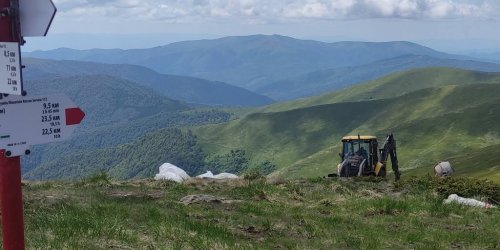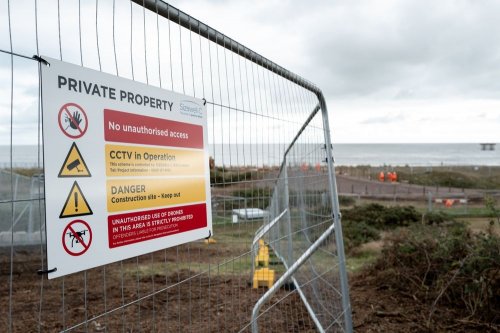Experts from the Ministry of Environmental Protection and Natural Resources of Ukraine have voiced the environmental consequences of the large-scale Russian invasion. The war has created numerous environmental risks that are escalating and threatening to increase the number of casualties among the population.
This was reported by the press service of the Ministry of Natural Resources.
Damage to nuclear installations, threats to nuclear and radiation safety
Nuclear and radiation safety of facilities in the Chernobyl exclusion zone remains a matter of serious concern. Status information for these objects is not available because:
a) The Chernobyl radiological laboratory was looted and destroyed by Russian troops;
b) communication with the monitoring posts of the automated radiation monitoring system is lost, data transmission is disrupted.
The latest data from the Automated Radiation Monitoring System in the Exclusion Zone were received from 6 observation posts on February 25-26. After that, communication with the Radiation Monitoring System was lost. The latest data showed an excess of background radiation by 8 times. The reason is the violation of the soil contaminated with radionuclides as a result of the movement of military groups.
On March 28, a Russian military convoy crossed the heavily contaminated Red Forest area and raised clouds of radioactive dust. To date, System data on the level of radiation in this area is not available. It was also reported that Russian troops built temporary fortifications and disturbed the soil cover in radiation-contaminated areas of the exclusion zone. It is not yet possible to estimate the impact on the level of radiation.
Zaporizhzhya NPP, captured by Russian troops on March 4, is used by the occupiers as a military base. Heavy weapons and ammunition are stored on its territory. ZNPP is under the control of the Russian military. At the nuclear power plant, 11 employees of the Russian state company Rosatom interfering with the work of the staff.
On March 28, at 14:00, Russian troops once again fired at the formation of the Kharkov Institute of Physics and Technology, where the nuclear research reactor "Source of Neutrons" is located. The object was also fired on March 26th. According to the State Inspectorate for Nuclear Regulation of Ukraine, due to the intense fighting that continues around this nuclear facility, it is impossible to assess in detail the extent of the damage and its impact on nuclear and radiation safety.
On Tuesday, March 29, IAEA Director Rafael Mariano Grosi arrived in Ukraine to organize urgent technical assistance and protect the country's nuclear facilities.
On Thursday, March 31, the IAEA reported that the Russian occupiers in writing handed over control of the Chernobyl nuclear power plant to Ukrainian personnel and began to withdraw two columns of their troops in the direction of Belarus. The third column left the city of Slavutych and also moved towards Belarus. When the troops left, the Chernobyl premises were looted, equipment and other valuables were stolen.
According to the State Agency of Ukraine for the management of the exclusion zone, there were no unauthorized persons at the site of the Chernobyl nuclear power plant on the evening of March 31.
Forest fires in the Chernobyl exclusion zone
As a result of the occupation of the Chernobyl Exclusion Zone by the invaders, a radiation catastrophe threatens not only due to accidents at industrial facilities, but also as a result of the burning of forests and fallows, which, after the 1986 disaster, accumulated a significant amount of radionuclides.
During the month of the Russian invasion and occupation of the Exclusion Zone, more than 30 large fires were discovered there, covering an area of about 10,287 hectares. The last major fire was 176 hectares.

Fig.1 Territories with forest fires in the exclusion zone as of 18:00 03/28/2022
After the occupation of the Exclusion Zone, we receive information about the fire from satellite images from NASA and the European Space Agency. And those are just the big fires. We do not exclude the existence of a significant number of smaller ignition sources. Cold and wet weather contributed to the fact that these fires self-extinguished. But with rising temperatures and a lack of control over the fire situation, an increase in fire danger is expected in the near future. Of greatest concern are the actions carried out by Russian troops in the heavily polluted zone of the Red Forest.
Recent attacks on infrastructure and industrial facilities
The Russian Federation constantly fires rockets at oil storage facilities throughout Ukraine. Rocket attacks on oil depots in Western Ukraine are carried out from the territory of Belarus and from the Black Sea.
On March 24, Russian troops fired at an oil depot in Kalinovka, Fastovsky district, Kiev region, before that they set fire to fuel tanks.
On March 26, fuel tanks were damaged as a result of rocket attacks on the territory of one of the industrial enterprises in Lviv. This led to a large-scale fire, which was extinguished the next morning.
On March 27, a fire broke out in Lutsk due to a missile attack on an oil depot.
Another large-scale fire occurred on March 28 due to a rocket attack on an oil depot near Rivne.
On March 29, Russian troops launched a missile attack on the oil depot of a military base near Starokonstantinov, 47 km from Khmelnitsky.
On March 30, another missile strike was delivered on the oil depot in the Dnieper.
The destruction of tank farms and large fires lead to toxic air pollution, land and water pollution with harmful substances throughout Ukraine.
Сhemical pollution
Russian troops are increasingly using banned white phosphorus incendiary munitions. This is fraught with large-scale fires and chemical soil pollution. Last week, phosphorus bombs were used in the shelling of Popasna and Rubizhne in the Luhansk region. On March 30, the Russians dropped phosphorus bombs on the city of Maryanka, Donetsk region, which caused a dozen fires. On March 22, they also used these munitions in the vicinity of Kyiv.
The environmental damage from the Russian invasion is huge and growing every day. Fuel spills, pollution from destroyed military equipment and weapons, and detonated rockets and aerial bombs all contaminate soil and groundwater with chemicals and heavy metals. More than 1,370 missiles have already been launched across Ukraine, and about 4,000 pieces of Russian military equipment of various types have also been destroyed. This leads to the accumulation of carcinogenic debris. After the war, the effects on the environment will take years to show.
With the current methods of conducting military operations, Russia grossly violates all norms of international law. According to paragraphs 1 and 2 of article 55 of the Additional Protocol to the Geneva Conventions for the Protection of Victims of International Armed Conflicts (Protocol I) of June 8, 1977, the armed forces during hostilities must comply with the restrictions and principles aimed at protecting the environment from large-scale, prolonged and serious damage. Such protection includes the prohibition against the use of methods or means of warfare that willfully destroy the environment or are likely to harm the environment and thereby endanger the health or survival of the population. The Geneva Conventions also prohibit troops from damaging the environment in retaliation.
Harm to nature reserves and protected ecosystems
As a result of the invasion, our natural heritage is increasingly being damaged. Today, more than a third of the territory of protected areas is used by Russian troops in military operations against the Ukrainian people. Currently, dozens of natural biosphere reserves and national natural parks have caused significant damage as a result of Russian aggression. The aggressor is conducting military operations on the territory of 900 objects of the natural reserve fund with an area of 1.24 million hectares. About 200 territories of the Emerald Network with an area of 2.9 million hectares are under the threat of destruction. Of particular concern is the destruction of Ramsar sites on the coasts of the Azov and Black Seas and in the lower reaches of the Danube and the Dnieper.
As a result of hostilities, part of the forests in the Kiev, Chernihiv, Sumy, Luhansk, Donetsk and Kherson regions are under the control of the occupiers. The forests contain a large number of detonated rockets, as well as unexploded ordnance. This is a potential threat to people and biodiversity for a decade to come.
Harm to water resources
During the offensive of Russian troops, shelling and bombing of cities and infrastructure, significant damage was caused to water supply, drainage and communications systems. This threatens fresh water supplies, leads to pollution of rivers, which are sources of water supply for industrial, municipal enterprises and individual households.
The treatment facilities of the Severodonetskvodokanal KP, the Lisichanskvodokanal KP, the Rubezhanskoye VUVKH KP, the Popasnyansky Vodokanal KP, and the Oblvodokanal KP were damaged. Because of this, untreated wastewater from Severodonetsk, Lysichansk, Rubizhne, Popasna and Zaporozhye pollute water resources.
Black and Azov Sea
According to a Ukrainian Foreign Ministry statement, the Russian Federation has placed naval mines as uncontrolled drifting equipment in the Black Sea. On March 26-28, 2022, such mines were found off the coast of Turkey and Romania. They were captured by the Russian armed forces in 2014 during the invasion and temporary occupation of the Ukrainian city of Sevastopol. Now Russia has used these sea mines in conjunction with a disinformation campaign and false claims in an attempt to portray Ukraine as a threat to civilian shipping.
Ukraine insists on bringing Russia to international responsibility for illegal activities in the Black Sea, war crimes and, in particular, the use of naval mines as indiscriminate weapons spreading uncontrollably in the Black Sea.
Ukraine, in compliance with its international obligations, informed the International Maritime Organization (IMO) about the use of drifting mines in the Black Sea by Russia during an extraordinary session of the Council and within the framework of the IMO Legal Committee, as well as to international partners through the channels of the International Automated Service (NAVTEX).
Currently, maritime traffic from all Ukrainian ports in the Black Sea is suspended. Dozens of commercial vessels remain in ports due to the threat of attacks by the Russian fleet, seizure or detonation of sea mines.
In the first days of the invasion, five commercial ships were hit by Russian missiles, one ship sank, and two more ships were captured and brought into the commercial ports of Crimea (Athena and the cargo ship Princess Nicole).
In the port city of Berdyansk in the Sea of Azov on March 24, a large landing ship "Orsk" was destroyed and sunk, several other Russian ships were damaged. Large-scale operations of the Russian Navy continue in the Sea of Azov.
In the case of the Black Sea, there are gross violations of the Bucharest Convention on the Protection of the Black Sea from Pollution.





